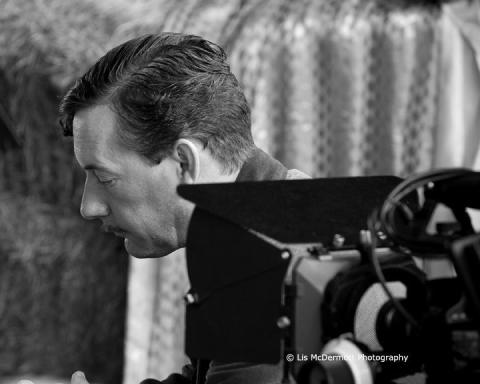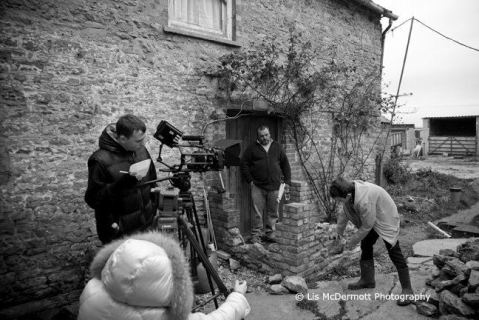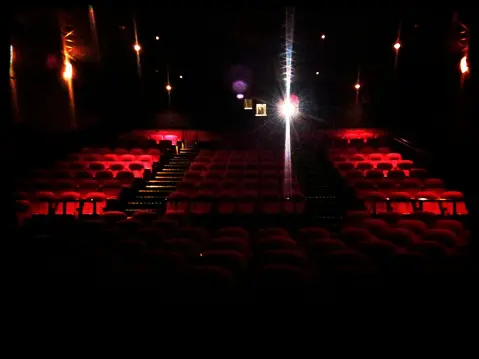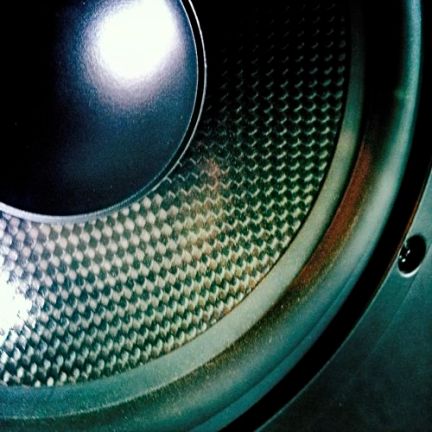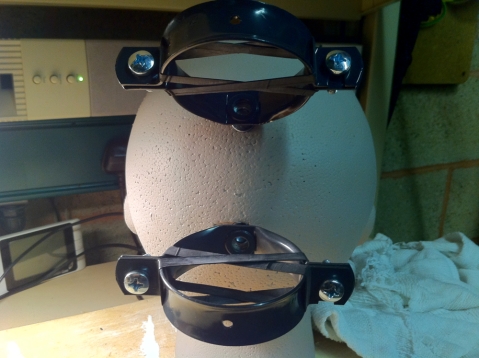‘Mr Wiggles’ – the sound process of a short film
June 7, 2013
Type in Mr Wiggles to Google and what do you get? A load of entries for the rap artist Mr Wiggles. However the penultimate entry on page one of Google – last time I looked – refers to another Mr Wiggles. This is far more interesting – to me at any rate.
Mr Wiggles is a Swindon-based short film, written and directed by Steve Ware and co-directed by Steph Palmer. In late 2011 Steve asked me if I’d be able to spare some time over a couple of weekends to record the location sound for the film and to act as sound supervisor on the project. As with all ‘no/lo-budget’ projects I was naturally skeptical, so I asked Steve for a draft script so I could read what it was all about. First read and I was hooked by this powerful family drama and simply had to be involved.
I went to recce the location with Steve and Steph a month or so before filming so I could get my bearings on the situation – this being a large run-down farmhouse on the side of an A-road and an accompanying large barn, open at the sides. My immediate impression was the sound of the road nearby. As a sound recordist I’m always thinking about the final product when making decisions on sound. Thinking about what I can get away with in terms of dialogue and how I can perhaps ‘cover’ up the sound of passing traffic if need be, especially for the exterior barn shots. Lot’s of close-up shots come in handy here, where I can get the boom in a close as possible to maximise the signal (dialogue) to noise (passing traffic) ratio.
During the recce I made some atmos and room tone recordings which I could later use in the film. I also recorded the sounds of the farm animals as I expected to be using some of these during the post production process. After all, the sound of a snorting pig pitched down can be quite dramatic!! I also ended up banging and hitting various farm implements, including a large rusty spring on the back of a grass cutter, which was later pitched and used in the trailer for effect.
Main shooting of the film took place over two consecutive weekends in November 2011. The first weekend turned out to be very cold with near or sub-zero temperatures for most of the time due to to a constant wind entering the open side of the barn we were filming in. Lots of layers, hats, balaclavas, scarves and gloves were required, as well as plenty of hot drinks! As sound recordist I was ably assisted on boom by Samantha and 2nd sound assistant, Shannon to record notes for each take. We were lucky to have such a comprehensive crew on this film, whose unyielding efforts really contributed to the quality of the final product.
The second weekend’s shooting was a little easier as many more of the shots were in the house so less effected by traffic noise and a lot warmer too!
Following a very intense but ultimately successful shoot we were now into post production. Initially I had offered to compose the music for the film, as well as doing the sound design, edit and mix. This initially seemed like a good idea and my first composition was some original music for a music box which is featured heavily in the film. Steve was keen that we have an original score for this which I duly delivered. The main music score was a different proposition and I was feeling under pressure to deliver as well as keeping my regular paying clients happy. Fortunately around this time I was introduced to composer Michelle Eaton through a mutual friend. I was immediately impressed by her compositions and asked if she might like to get involved in the film. She said yes! I’d been messing about with a couple of ideas, which basically consisted of a series of nine notes!! A catchy riff but very far from a proper film score. I played these to Michelle and a week later she had transformed my initial idea into something wonderful and immediately engaging. A few tweaks later and we had a main score for the film. From this Michelle composed a series of moods to go with the unfolding of the film.
The last music track in the film was written and performed by Daniella Faircloth and Matthew Mordak. I recorded and mixed the music at Dreambase Studios and a music video was later created for the song at the film’s location.
At this time the picture edit was more or less complete so I was editing/processing the dialogue and adding fx and atmospheres to the soundtrack. I’d already completed a short teaser trailer for the film with some temp music, which was later changed using Michelle’s score. Michelle’s music was the last element to be laid up to the main project and this is pretty usual for most films. Ideally the composer would be bought onto a project at pre-production stage but logistically this doesn’t always happen. The music was track-layed using Michelle’s notes and with some further editing and mixing we were approaching a theatrical mix which could be played back in the local multiplex for the premiere. We had a couple of evening sessions at the studio with the core team to go through the soundtrack and get approval before it was mastered out and married with the graded picture, ready for the first showing. When the crew actually have tears in their eyes in the studio you know you’ve done a god job; emotions were running high – in a good way!!
Next event was the screening in the local multiplex cinema. I had mixed the film knowing it was going to be re-played in this environment so was pretty confident everything would be played back at the right level and all the dialogue would be understood. The sold-out charity premiere was a superb night and marked the end of the first stage of the film’s progress.
Mr Wiggles has so far been shown on the festival circuit in Asia and is currently showing in America. I wish it all the very best, especially given the hard work, commitment and attention to detail from everyone involved.
You can keep updated on Mr Wiggles via the Facebook page here.
Mr Wiggles is about the imaginative distraction we all desperately desire from reality. The film takes the lives of two young children’s desperate escape, into a world created for protection. But for Amber and Nathan, it’s only a matter of time before reality, catches up.
BBC’s ‘Parade’s End’ – don’t blame the sound crew!
August 27, 2012
I haven’t written here for a little while due to to other projects, including a house move. However I watched ‘Parade’s End’ last week and then, a day later, the comments regarding the sound of some of the dialogue. As a result I just have to speak in defence of the entire sound crew and point the blame to other areas.
In fact, some of the comments regarding the sound quality such as bad mix, levels too low, etc., underline how little many understand about sound – even that of their own voices. In my opinion the main problem here was the slightly inconsistent performance from Benedict Cumberbatch (in the main). He was dealing with a tricky-to-deliver accent and at some points I thought the voice was simply too theatrical. This led to certain sentences, particularly at important moments being delivered in a less than clear manner. Cumberbatch is a fine actor, but in this role he looked a little uneasy with the character I thought. The movement of his mouth was also restricted, I suspect, due to the accent and characterisation here. This certainly doesn’t help with our understanding of the dialogue, regardless of it’s overall level.
I’m sure the sound was recorded and prod mixed correctly from the outset via boom and/or radio mic, but if the performance is mumbled, etc. there’s little that can be done to help it. Dialogue delivery isn’t just about level – it’s the attack, sustain and decay that’s important too. One option would be to ADR (dialogue replacement) certain sections but not all directors/producers are keen on this method as the loss of adrenaline in the recording studio can lead to a less than impassioned performance. There was ADR in this episode, as there is in many productions, and most people don’t notice post sync dialogue anyway and would assume it was done during the recording of the scene on set.
In any case sound often gets the lowest attention on a typical production. Why, when it constitutes more than 50%* of the finished article? Sound adds the emotion to the picture so why are budgets and time being reduced on the sound side. Crafting a convincing soundtrack (i.e. one that no one notices but thoroughly enjoys) takes time, effort and great understanding from the entire sound crew. So please can we all, from Directors and Producers, to the viewing public please remember the love and effort thats gone into creating the soundtracks that we all take for granted these days.
*OK, so I’m slightly biased!
The opinions expressed in this blog are solely those of the author.
Adam loudspeakers: why I like them
June 15, 2012
Just realised my goal of a blog-a-month has passed, with May being non-existant in terms of content. June is well and truly here (you’d never know it from the skies) so I thought I’d bang something brief together about the speakers I use.
Loudspeakers are always an emotive subject. Audiophiles, mixers, musicians: they all have their own favourites. And will fight to the verbal death to defend the make and model which floats their own auditory canal. Speakers are like cars – not just because they are potential pub talk – but because we get to know speakers (much like cars). We understand the frequency response (driving characteristics?), we appreciate the look (the curve of the bonnet?), we know how hard to push them (handling?), and we know what they excel at best (city car or load lugger?).
I’ve listened to a fair few speakers in my time (here’s a small selection):
- Those ‘no-brand’ biege ones you used to get with IBM computers: OK if you turned up the treble, right?
- Tannoy Westminsters in my local music recording studio: lovely, big and warm sounding.
- The Yamaha NS10‘s in the same studio – OMG, what’s that flat sound?
- Home made hi-fi boxes with 2-way Morel drivers: I thought they were amazing, but then I did build them….
- Shermann Audio touring arrays: use 2 for my bands PA – they are very crispy.
- Huge 3-way JBL screen arrays in cinemas: close to a hifi sound from a horn loaded enclosure.
The last speakers mentioned are probably those I’ve listened to most from my thirteen years as a sound consultant at Dolby Laboratories, setting up cinemas and film mixing theatres all over the world. I’m referring to horn-loaded systems in general, not just the JBL brand: Martin Audio, Altec, KCS, etc. Horn-loaded HF systems have been used in cinema playback systems for many years, and the smooth response in the 2kHz and upwards range always impressed me, especially in the latest systems. During my time at Dolby I also setup studios with dome tweeters and I could never get the smooth response I really desired and had heard in the cinema.
That is until I came across Adam loudspeakers. I first demo’d the A7’s at a studio in Denmark. I was immediately taken by the smoothness in the the all important upper frequencies of the dialogue spectrum – this was what I’d been looking for and they seemed to closely resemble the response of the best horn-loaded cinema speaker systems. And all this from a near-field speaker with a very small footprint – with ‘foot’ being the operative word!
I started using the A7’s when I set up my own sound studio, quickly moving onto a complete 5.1 setup of Adam’s. I did experiments between the studio and local cinema in order to best set up the speakers in their environment from both a level and equalisation stand point. The first feature film mix I did on them bore out the capabilities of these speakers. The dialogue I’d mixed in my small studio translated beautifully into the cinema environment with little ‘pre-emphasis’. This is important as I didn’t want to have to over or under-do anything in my own studio in order to have good playback in the cinema environment. I needed my small studio to be faithful to a larger cinema space and it’s systems.
Apart from careful setup of the speakers, a big contributor to the success of these units are the ribbon tweeters. They appear to come as close as possible to the horn-loaded systems found in cinemas, making film mixing a thing of confidence, even in a smaller room.
And their capabilities don’t stop there. At Dreambase Studios we don’t just do cinema mixes: we also mix audio for DVD, broadcast and the web. In each of these areas it’s vital to know what levels you need to be monitoring at to get the best delivery. The Adams certainly make that task a lot easier. You are given a head start on frequency and transient response so you only have to worry about the monitoring levels before you start creating for your chosen delivery medium.
In fact the Adams are so detailed, they playback every little click and pop that might be missed on traditional dome tweeter systems – this allows for a thorough and effective ‘technical’ cleanup of audio, as well as a creative one.

So there, I’ve evangelised about some speakers. I’m so used to these speakers now I wouldn’t consider any other make when it comes to near or mid-field monitoring. In a professional production environment you want speakers to help you both creatively and technically. To this end, the Adams come as close to providing both of these requirements in equal measure as any speakers I’ve listened to.
Long may they continue and make my job just that little bit easier!
The opinions expressed in this blog are solely those of the author and do not represent official policy or endorsement of any of the products mentioned.
Sound Post for Verity’s Summer
April 19, 2012
I recently completed sound post production at Dreambase Studios on Verity’s Summer, a new feature film by Palme D’Or nominee Director, Ben Crowe.
Verity’s Summer is the story of a young woman’s journey from the security of childhood to the compromises of adulthood and moral ambiguities of love. It is also an intimate portrayal of a family coming to terms with the traumas and violence of distant war that are brought back home.
The film stars, Indea Barbe-Willson, Martin McGlade, James Doherty, Nicola Wright, and Christian Hogas and was shot on location in the North East.
The ambiences are very important in Verity’s Summer and I wanted to create definite ‘backgrounds’ for each scene. The coast is ever present in the film and so from a ‘sound tag’ point of view I wanted to make sure the sea sounds were distinctive and repeatable if necessary in order to reinforce the scenes.
I spent a weekend in West Wales recording lots of different locations for the film. I’d already spotted the film for what I needed to record but I took a rough cut of the film on my iPhone so I was able to get an idea of perspective there and then when making decisions on where to position the microphones for the best recording. I took many different sound perspectives from close up to the waves, to many hundred meters away, at times. I also took recordings of the countryside nearby as these also play an important part in many of the scenes in Verity’s Summer.
A chance recording I made of some sea birds defending territory on one of the beaches was also very useful in several scenes during post production. I chose Wales partly because it offered the same ‘sound feel’ as the visuals had suggested to me but also because it is largely free of interference from transport such as aircraft, motorways and trains. In fact, recording on location in many parts of Wales is, at times like having your own outdoor studio, such is the absence of external sound interference. And I also love visiting this area, so it was a good excuse for a short break!
Ambience recordings were combined with other sounds in order to subtly change the mood of the film as a scene progressed. For example, I was keen to make sure we had simple but dark textures in some scenes, particularly the more difficult dialogue subjects. In others, such as Verity’s garden I wanted to make the sound detailed and comfortable, as the garden is often a place of solace for her.
Among the many Foley sounds we recorded, were a variety of Trangia sounds for when one of the characters (Martin McGlade, as Castle) is eating in his encampment. My Dreambase Studios co-director, Mark Kenna enjoyed a lunch of cold baked beans and stale bread that day in order to complete the Foley recording for the scene, but once edited in it worked tremendously well and was absolutely necessary due to rain interference on the original production tracks.
Verity’s Summer premiered on 21st April at London’s Shortwave Cinema.
Sound Post for ‘Harsh Light Of Day’
January 4, 2012
I recently completed the sound post production at Dreambase Studios on British Independent Horror film, Harsh Light of Day. Directed by Oliver Milburn and produced by Emma Biggins at Multistoryfilms. I worked with them to create a dynamic, theatrical mix that keeps you on the edge of your seat.
SYNOPSIS: After returning home from the launch of his book about the occult, Daniel Shergold’s house is broken into by thugs, who beat his wife to death and leave him paralyzed. A depressed agoraphobic in his secluded country cottage, Daniel mourns the death of his wife while being cared for by home nurse, Fiona. He is unable to accept the lack of success the police have in finding his wife’s killers. Daniel accepts a visit from a mysterious stranger who insists he can help him reap revenge. He agrees and is thrown into a strange and horrific transition into darkness. With renewed strength, Daniel sets out to avenge his wife’s murder, but at what cost?
From the outset HLOD needed a soundtrack that was set ‘completely in reality’ one minute and then going ‘off on one’ the next. These dynamics were intended to give the viewer a full gamut of aural experiences, from a comfortable almost anodyne setting to uncertain, or at times excruciating pieces.
Shooting outdoors and on the coast presented the usual sound issues, so wild tracks, Foley recordings and sound design were used extensively to convey the appropriate sentiment in these scenes, from water lapping on a pebbly beach to the atmosphere of a dock yard. In contrast, the ‘sound’ of the house in the film is almost silent, again to emphasise the isolation of the cottage and to ensure the film exhibited plenty of sound dynamics.
The film’s producer Emma Biggins commented at the premiere: ‘the screening went really well tonight – looked and sounded fantastic’
HLOD is released in cinemas on Friday 13th April 2012 and the theatrical trailer can be seen here:
Music for ‘Lisa’s Story: On My Sleeve’ documentary
January 3, 2012
I recently completed some music compositions and a sound mix for Stephanie Palmer’s documentary about asthma sufferer Lisa and the steps she’s taken to cope with the condition. Called ‘Lisa’s Story: On My Sleeve’, the documentary was made as part of a series of films for Asthma UK and Big Up Your Chest TV to highlight the condition and how it affects the lives of those who suffer with asthma.
The guitar pieces for the film were intended to be simple and light-hearted but also to have a thoughtful tone and feel. This was designed to convey the subject matter and Lisa in the best possible way, and to complement Stephanie’s editing style. The edit audio from Final Cut was remixed and treated to reduce the large amounts of location interference from pedestrians and other building-related sounds. Extra ambience was added to add emphasis to the different locations in the film.
The film can be seen here:
DIY Binaural Head – Part 2
November 21, 2011
In part 1 of this we looked at the head itself and microphone mounts along with the painting of the assembly.
Now after a little head scratching and failed mountings I’ve arrived at a solution that not only mounts the head securely, but also offers some isolation from the stand or boom pole onto which it is attached.
The clamps I used were left over from a recent boiler installation – they are designed to screw into an outside wall and used to mount the plastic chimney outlet of a boiler. The clamps were instead screwed into the back of the dummy head and over these clamps were stretched some off-cuts from an old bicycle inner tube.
These are used to house the mounting rod and provide some handling isolation from the head-mounted microphones. The rod is a camera tripod mic mount and fits snugly in the rubber bands.
The snug fit of the assembly enables the head to be positioned at a variety of angles. Due to the fiction created by the rubber bands the head will not slip down the pole on which it is mounted. this means that virtually any length pole can be used up to a diameter of around 20mm. With suitable length microphone leads, this means the head can be positioned in situations where a human might not otherwise be able to get access to. In this example the rod is screwed to a 3-piece camera mono-pod.
Here is the head in action on one of the test recording locations – in this case on a motorway bridge! The microphones used in the head are currently cheap omnidirectional electret 48V phantom-powered capsules. Lets see how I get on with these in lots of different locations before upgrading to something a little more expensive and lower noise. Wind protection is provided by some modified Rycote Overcovers fixed back-to-back and slipped over the capsules – much cheaper than purpose designed mini mic windshields.
I’ll be doing some test recordings in the run up to Christmas, so stay tuned for some audio evidence…
Theme Music for Hoverchase 4D
November 9, 2011
This is the theme I composed in Logic Studio as part of the overall sound design Mark and I did at Dreambase Studios for a theme park ride called Hoverchase 4D. It’s a breakbeat style intended to keep the pace of the ride from beginning to end, and to complement the speed of the visuals and the multilayered sound effects in the ride.
Hoverchase 4D was produced by Lightworx Media and is distributed by The Juice. The trailer can be seen here.
DIY Binaural Head – Part 1
October 31, 2011
I’m in the process of designing a binauaral head with the aim of using it to capture sounds for some of the projects I work on, both commercial and personal. This might include ambience (winds, traffic hum, water, etc.) or even location dialogue. I know what you’re thinking – surely that’s just for playback on headphones? Well true, it’s at it’s best in that application. However I’m also experimenting with settings that will translate the location binaural recordings into effective audio sources for playing on normal loudspeaker systems. Binaural is already mono compatible though.
The head
So what happens first? Well I bought a polystyrene head off Ebay. I chose a man’s head because I couldn’t find a woman’s one that I liked and this example was suitably macho and ‘hi-tech’ – I think!
Microphone mounts
I then fixed some large wood screws in each ‘ear’ of the head. These will be used to hold the microphones in position. I found the 5 x 70mm Screwfix ‘Goldscrews’ to be best for this purpose, with a sure-footed thread into the poly and enough diameter to spread the load in the relatively soft head material.
The paint
I painted the head with some household paint that I had left over from decorating the cinema room. The Dulux ‘Potters Wheel’ matt emulsion gave a hi-tech [that word again!] look to the head.
The next time
That’s it for now. In Part 2 I’ll be painting it again (and maybe again), and I’ll be making the all-important ‘shock mount’. We will also look at the mics and various accessories that go with the head.
Stay tuned for Part 2…


